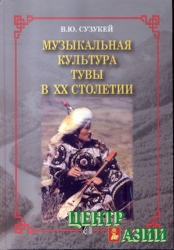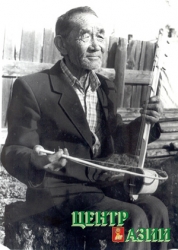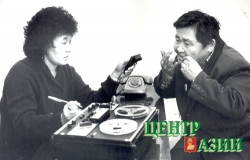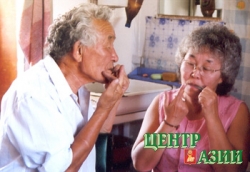 — Valentina Yurievna, you presented the sum of your understanding of Tuvan musical culture in your book “Musical culture of Tuva in the XXth Century”, which was published in Moscow in 2007. — Valentina Yurievna, you presented the sum of your understanding of Tuvan musical culture in your book “Musical culture of Tuva in the XXth Century”, which was published in Moscow in 2007.
At first, you used to approach your subject with western education,, with western theory – you asked questions that you were taught to ask, measured by methods and instruments with which you were equipped during your studies.
Later, as you write, you started to comprehend that it is impossible to understand or document this culture by foreign means.
Tell us, please, for those that did no read your book, how did this change come about? What happened?
— That is a very interesting question. I think that my case is an interesting example for analysis of the methods of scientific study and evolution of the researcher herself, as at a certain moment, the material itself pushes her into movement. In the 1980’s, when the old masters were still alive, I used to visit them, talk to them, and record their stories and music. And for a long time, there was a lack of comprehension in our conversations. They had their own knowledge, and I had my own.
Sometimes I sat there, thinking, when will they start talking to me about music. In my understanding, “talking about music” meant discussions about tonality, about composition.
But they would sit there and tell me: “Look at the mountains close up, and at those in the distance. There are shadows of clouds. And there are colors.”
Marzhymal Ondar, for example, said: “We are sitting here talking, and at the same time somewhere a dog is barking, an old woman growling ( that was about his wife, she was banging and rattling with pots and pans in the yurt), a baby is crying.”
He was trying to explain to me how many different sounds are all around us, but, nevertheless, we are still able to hear each other.
 I asked Salchak Shombul to show me the tuning, as I was instructed in the Novosibirsk conservatory, to play the sounds of each string of the igil separately, to bow them separately with the bow. I needed to record it on the tape-recorder. But he bowed both strings simultaneously. I stopped recording, and asked: “First one string, then the other.” I asked Salchak Shombul to show me the tuning, as I was instructed in the Novosibirsk conservatory, to play the sounds of each string of the igil separately, to bow them separately with the bow. I needed to record it on the tape-recorder. But he bowed both strings simultaneously. I stopped recording, and asked: “First one string, then the other.”
He looked at me with surprise: “But you asked about the tuning!”
“Yes, the tuning!”
I turned on the recorder, and there he went again – both strings at the same time. I turned off the recorder.
We were looking at each other, it was obvious that I was beginning to irritate him with my incomprehension. “You are really strange”, said the old man. He put his igil away: “Go drink some tea, I will have a smoke.”
He left, and I was thinking how stubborn he was, why couldn’t he do such a simple thing. At the same time, he was also mad at me, I could see him from the window, smoking nervously. I’m sure that he was also thinking how dense I was.
If you made a movie on the basis of this episode, I think that it could be very interesting!
— The name of the move would be “Collision of Cultures”.
— Yes, precisely. We were both saying “khoon”, (tuning, pitch), but we each had a different meaning for it. I did not understand anything then, not even when I deciphered these materials. I got it later, after many years, when this master was no longer among the living…
The riddle of the old masters
 — And what was the cause of the misunderstanding? — And what was the cause of the misunderstanding?
— It is because at school, at the institute, before rehearsals, the concert-master would always give us the absolute pitch “la”, 440 Hz, everybody would tune the corresponding string of their instruments to it, and the rest of the strings in relation to that. I was racking my brains: How do the national musicians tune this “la”, when they do not know what it is. But for an oral culture, there IS no absolute pitch! There is no concept “La”, there is no orientation to 440 Hz!
For our musicians, the absolute pitch is not important, that is, the position of that sound in space, but what is important is the relation of the two strings to each other, to the pure consonance of the quinta, a soft sound, harmony.
They never used those words in their lives, and did not understand their meaning, but they played it as it could sound in nature.
In academic music, the 440 Hz pitch is an unshakable constant, you must not be a tiny bit higher or lower. It ties you down, it grounds you.
But for the old masters, this value is not important, but the interval between the two strings, that is their constant, in that, there has to be absolute precision!
And that is why Salchak Shombul understood the tuning of the instrument as verification of the simultaneous sound of two strings. To bow each string separately was simply meaningless to him!
I remember another episode.
Old master Idamchap was both a great khomus player, and also a wonderful maker of khomuses. He often gave me his creations. One of my khomuses developed a bad sound, the tongue would bang against the edges of the instrument, and that caused rattling. I went to see Idamchap, and showed him the instrument. For him, it was very easy to correct something like that.
The master took it, wanted to repair it, but the tongue broke off completely. He put it away, and promised to either make a new one for me, or fit a new tongue to the old one.
 Many times before I had asked him: “Why is the drone string necessary?”” I could not use specialized terminology, because that is something that even contemporary educated people do not understand. Many times before I had asked him: “Why is the drone string necessary?”” I could not use specialized terminology, because that is something that even contemporary educated people do not understand.
So I kept asking about the “droning string”, which made up the base of the melody. I tried to ask him this question this way and that way, him and other musicians. They would just shrug their shoulders, and did not understand what I was asking about. Only now I understand that I was speaking a completely different language.
That time, Idamchap put away the broken khomus, and started playing his own. I, as usual, was recording his playing. Suddenly he stopped and said: ”You are always asking this strange question about the droning string. Now that the tongue of the khomus is broken, can you still play it?”
What he meant was that the droning string was the foundation for the melody.
These episodes were all stored away in my memory, made me think, analyze, search.
And one day I saw the light: I finally understood where their truth was, what they were trying to tell me. It happened so suddenly that I almost jumped up, and smacked myself on the head.
So, already in the early 1990’s I started to write about the drone-overtone specifics of Tuvan music.
Tones and overtones
— What is the root of these specifics?
— This question is even more interesting!
Starting with Aksenov, musical folkloristics, which was a branch of theoretical musicology, operated with the terminology and methods of academic theory of music. That meant that Tuvan music, just like any other music, was written down in notes by specialists. All the sounds were treated as separate entities.
The foundation tone, which sounds constantly at the same pitch, was written separately on another line of music note paper. The melody was written down on another line. Then later, when the music was analyzed, they looked only at the melody, they analyzed the intervals between the tones, etc. The foundation tone was ignored. That way, they completely lost the specificity of the music.
But the crucial factor is that in Tuvan music, everything is based on the mutual relationship between the drone – the foundation, and the overtones, which are not independent sounds, but fractions of the drone.
Namely this type of organization of sound material remained incomprehensible to the researchers, the theoreticians, for a long time. They tried to apply their usual methods, but these were totally inapplicable.
As a sequel to my last book, I want to write a monograph about the incorrect use of academic terminology in relation to Tuvan music. I take each term, like range, or scale, with its definition, (and each of them has a whole chapter in the history of art standing behind it), and discuss why it is inapplicable.
The relationship between the foundation tone and the overtones can be explained by a simple school example from physics.
 When a ray of light passes through a glass prism, it is broken up into a whole spectrum. That is approximately the mechanism acting in Tuvan music. It is as if the base sound was fragmented into pieces. When a ray of light passes through a glass prism, it is broken up into a whole spectrum. That is approximately the mechanism acting in Tuvan music. It is as if the base sound was fragmented into pieces.
And those pieces are the overtones – fractional tones of the base tone, and only of that. The base tone has to always be present for the musicians to make music, to use the fragments, the overtones, to make up the melody.
If you take away the original ray of light, the entire spectrum, which is coming out of the prism on the other side, disappears. It is the same in our music: when you take away the base sound, the overtone melody also disappears. The overtones have no independent source of existence.
If you play a melody on a piano, every note, every tone is produced by striking one separate key. If we play a string instrument, the principle is the same: you press here – that is one length of the string, a source of a certain sound; press somewhere else, and that is another length, another source.
Organ music or piano also often use a drone, but it is produced by other pipes or keys, and the melody on others. There is no overtone music in academic music, it is only a special effect used now and then, for decoration, all the melody is made up from non-overtones, from independent sound units.
In Tuvan music, there is only one source of sound! If you speak of khoomei, it is here (she points at her throat). The source of the sound is always one only, and the overtones are formed by the position of the lips, and depend on changes in the position.
With the khomus, the tongue is the source, and it does not ever become longer or shorter, it always vibrates along its whole length. Same thing with the igil, byzaanchi, shoor, doshpulur – all of them are instruments with a drone string.
It turns out that the melody produced from overtones has no independent source of sound, it is an ephemeral, virtual reality.
— I remember one of Sainkho Namtchylak’s music projects, “Virtual reality”. But even if the singer can afford to use any figurative expression, it seems to be a very brave step if such a term is used by a scientist.
Can you say it like this: movements of fingers on the keys and the sounds that are produced are, respectively, cause and effect. But in this music – are the overtones effects of effects? Is that what you mean by the term “virtual reality”?
— Yes, this music has a completely different technology. Often even the performers themselves, of, for example, sygyt, can’t explain how they are able to produce such penetrating sounds.
The smallest movement in the position of the lips, and a completely different overtone becomes audible. If you turn a multifaceted diamond only a tiny bit, the reflections change.
You had to hear that!
— So how would you document, or write down, such virtual reality? Or perhaps it is better not to write it down at all?
— That is precisely the question! That is what I am going to write about in my next book.
It is because this drone-overtone nature of the sounds is analogous to nanotechnology. Nanotechnology is not a material thing, it is a characteristic of dimension. We are speaking of fractional tones, overtones, which can be viewed at the level of atomic structure.
How does one document it? I will tell you about my last trip to Finland. There was a world music seminar in the conservatory of the town Joensuu. I went there with Eduard Damdyn, from the ensemble Tyva, who works at the Filharmony.
It turned out that in Scandinavian countries, they stopped using note writing in the departments of folk music in the 1970’s. Nobody teaches anybody from the notes anymore. You can do recordings, but most of all, they use workshops. We were present at one of those.
The teacher sat down with his instrument, the students sat around him with their instruments. They listened how he played the melody, just one part, then they repeated it after him. Eduard revolted – what a kindergarten – and went outside to have a smoke. But I stayed there, listening and observing. The instructor showed how the low tones are to be played, then he worked with the middle instruments.
In the end they put all the layers together, and started playing simultaneously. At that moment Eduard came back and was astounded: “They learned it so fast?” “You should have heard that”, I said to him.
There were also workshops in folk singing. The seminar was one week long, and in several days, everybody learned compositions of Karelian, Swedish, Norwegian, and other musical and song cultures. And at the end, we held concerts all together.
In Alma-Ata Conservatory, they also stopped using written notes in the department of national instruments long ago.
Not from the notes
— And how about here?
— (A heavy sigh). No matter how much I write and lecture, it turns out that I am the only one fighting this Eurocentrism in the center of Asia. When even in Europe they got away from it.
In the art school, they teach the performers on national instruments from written notes to this day, believing that this is how it is supposed to be. It is the heritage from the Soviet epoch, when national music was viewed from the point of view of European theory of music. Now the whole world got away from this practice, but here it is cultivated to this day.
—
In your book, you write about inviting Khunashtar-ool Oorzhak as instructor in the art school in 1980’s, about how they circumvented the problems of methodology materials, which he, naturally, did not write. That experience had no results?
— None. It fell through, nobody got anything useful from that.
Now young musicians study, and receive diplomas. Somebody finished the Novosibirsk conservatory, somebody else the art school. And with these documents, they go on to teach at the art school.
— But in truth, they are not really prepared as national performers, but as some sort of falsificates?
— Yes, unfortunately. They are so far from the traditional, purely Tuvan music, that there is almost nothing left.
And the instruments that they are taught to play, are not traditional either, but enhanced, redesigned for orchestra. All that is left is the name “Department of Tuvan national instruments”. But in reality, it is not national music at all.
Igil is a violoncello, byzaanchi is a violin
— But are there still some performers of pure national music?
— Yes, there are. But there is the problem of preparation. People need documentation about education.
And there is another side to the problem. The instructors run into the problem of pedagogic documentation. The instructor is expected to present a documentation of the repertoire that he teaches.
To put together methodology materials is a special type of activity that is not easy for everybody. There are certain requirements and standards, patterns of formulation of the educational methodologic literature. It is not just program or plans, but also textbooks. It takes years to work that out.
In any case, the repertoire has to be written in notes. Oral methodology is not acceptable, because there are educational standards, established in Moscow. Any inspector will adhere to them.
Even though, after all, a small “window of opportunity” opened up – lessons called “national-regional component”, where the program can be individual. But they still put the instructors into a very difficult situation.
So what does an ordinary instructor of igil or byzaanchi do, when he has to present a teaching program for accreditation?
He writes a text and asks me for an evaluation. I look at it, and see right away that his program is an exact analog of the program for violoncello. Instead of “violoncello”, he substitutes “igil” in the text.
And for the byzaanchi, they use the program for the violin. Everything is understandable to the inspectors, because it has the correct style, and the material is ordered a certain way. It makes life easier for everybody.
Windmills
— And you, with your position and insight, what kind of evaluation do you write?
— My first reaction, when I was young, was to give a negative evaluation. But if you criticize something or somebody into shreds, it does not have any good results.
First, the instructor gets offended. Second, he goes to somebody else, who will give him a better evaluation. Third, the administration of the school also needs to pass accreditation without problems.
In principle, it all goes through the established method, which works within the framework of the necessary standards.
If you want to change anything, you have to act not from below, but from the top – where the standards are worked out.
— In such a way, in your words, this fight looks quite don quixotic?
— Precisely! I am still fighting with windmills. Eurocentrism – it is such a thing, you can’t touch it, you can’t feel it with your hands, but it has such an effect, gods help you!
But I am happy that in other countries things have already changed. Our turn will come too. Definitely!
|
